-
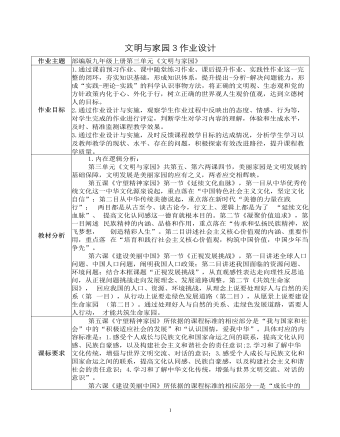
九年级上册道德与法治文明与家园3作业设计
参考答案:(1) 人与自然和谐共生。(2) ①国家:加强立法,完善资源环境方面的法律法规,严格执法;坚持保护环境、节 约资源的基本国策,坚持可持续发展战略;处理好经济发展与环境保护的关系,走绿色、 循环、低碳发展之路;建设资源节约型、环境友好型社会。②企业:增强社会责任意识, 依法履行保护环境的义务,落实节能减排政策;加大环保资金的投入力度;依靠科技创 新,提高资源利用率。③个人:学习和宣传环保知识,践行低碳生活方式;从身边小事 做起,落实环保行动;积极向有关部门献计献策:勇于同各种破坏生态环境的行为作斗 争等。(3) 有一种习惯叫光盘,有一种意识叫珍惜,有一种美德叫节约;我们要尊重汗水和创 造,弘扬中华民族勤俭节约的传统美德等。(言之有理即可)(4) 答案示例:王经理,您好。我是“光盘行动”的志愿者,看到咱们酒店的餐饮浪费 比较严重,冒昧给您提个建议,您能否让服务员在点菜时提醒顾客要适量(为顾客提供 “半份菜”“小份菜”),以减少浪费,希望您能采纳。
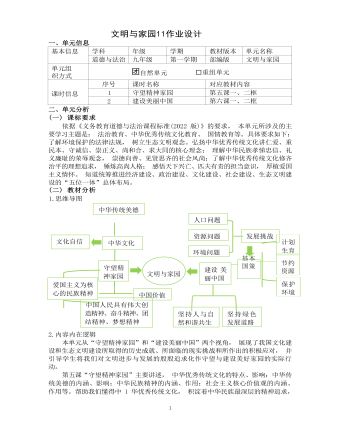
九年级上册道德与法治文明与家园11作业设计
7.最近, 国内多地报告发现了入侵物种——加拿大一枝黄花。它最开始是作为一种 观赏植物被引入中国, 却由于繁殖能力强大, 导致周围其他植物的区域性灭绝, 带 来严重的生态危害。对此,下列建议你认为合理的是 ( )①将野外的一只黄移植回家放在阳台观赏②发现可疑物种及时向有关部门报告③加大宣传教育和引导,帮助公众认识和辨别④积极开展集中灭除行动A.①②③ B.①②④ C.①③④ D.②③④ 8.无论是黄河长江“母亲河”,还是碧波荡漾的青海湖;无论是南水北调的世纪工 程,还是塞罕坝林场的“绿色地图”;无论是云南大象北上南归,还是藏羚羊繁衍 迁徙……这些都昭示着人不负青山,青山定不负人。这说明 ( )①人与自然相互依存,共生共荣 ②生态兴则文明兴,生态衰则文明衰③环境恶化加自然灾害的发生 ④绿水青山就是金山银山A.①②④ B.①②③ C.②③④ D.①③④
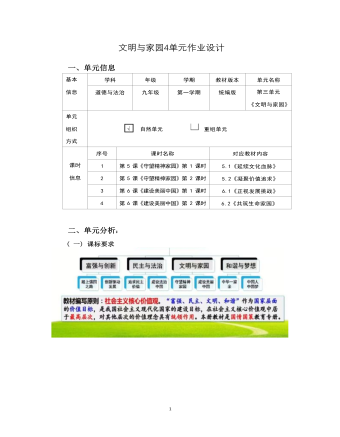
九年级上册道德与法治文明与家园4作业设计
第五课“守望精神家园”的主要内容是:了解中华文化的特点、内容;理解 中华优秀的传统文化;新时代传承和发展中国特色社会主义文化;把握文化自信 的重要性并积极增强文化自信;以实际行动践行中华传统美德;理解伟大民族精 神的内涵和作用,积极培育民族精神,做民族精神的建设者、传播者和实践者; 正确认识社会主义核心价值观的重要性,理解社会主义核心价值观的重要性,熟 悉社会主义核心价值观各个层面的价值目标并培育和践行社会主义核心价值观。本课作为本单元的起始课,作为中华优秀传统文化学习主题,帮助学生认识 中华民族五千多年的历史创造了悠久灿烂的中华文明。理解中华民族孝悌忠信礼 义廉耻的荣辱观念,崇德向善、见贤思齐的社会风尚。中华民族屹立于世界东方 熠熠生辉,对一个民族而言,其根基在于文化的力量。中华优秀传统文化是中华 民族在世界文化激荡中站稳脚跟的根基。中华灿烂的文化形成了代代相传的美 德。贯彻十九大六中全会精神:“文化是一个国家,一个民族的灵魂。文化兴国 运兴,文化强民族强。没有高度的文化自信,没有文化的繁荣兴盛,就没有中华 民族伟大复兴。”
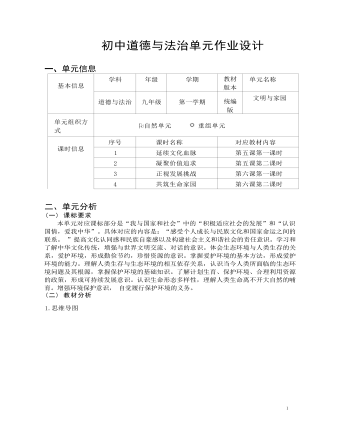
九年级上册道德与法治文明与家园7作业设计
一、单项选择题1.冰墩墩,是2022年北京冬季奥运会的吉祥物。 将熊猫形象与富有超能量的冰晶外壳相 结合,头部外壳造型取自冰雪运动头盔,装饰彩色光环,整体形象酷似航天员,充满未 来科技感。冰墩墩寓意创造非凡、探索未来,体现了追求卓越、引领时代,以及面向未 来的无限可能。吉祥物一经面世,就受到了各国人士的普遍喜爱和疯抢。“冰墩墩”的 设计 ( )①说明设计者的灵感来源于生活 ②将传统与现代文化相融合而富有创意 ③说明文化既是民族的,也是世界的 ④说明文化特色越鲜明越有价值和活力A .①②③ B .①③ ④ C .②③ ④ D .①②④ 2.《安徽省“十四五”生态环境保护规划》 (以下简称《规划》)印发。到2025年,全省 将实现生态环境质量持续改善,细颗粒物(PM2.5)浓度总体达标,基本消除重污染天气, 优良天数比率进一步提升;水环境质量全面改善,水生态功能初步恢复。早日重现“一 江碧水向东流”的胜景。我省实现生态环境保护规划的目标需要 ( ) ①先污染后治理 ②走绿色发展道路 ③建设生态文明 ④实现可持续发展A.①②③ B. ①②④ C. ①③④ D. ②③④
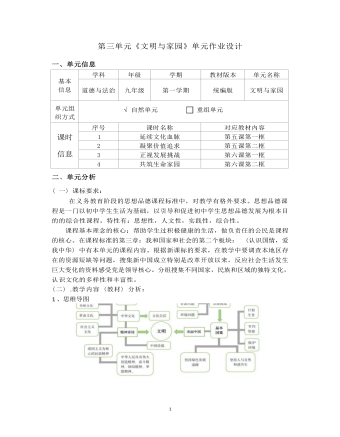
九年级上册道德与法治文明与家园10作业设计
( 一) 作业内容《环保倡议书》微型讨论会一、活动步骤1.对全班同学进行分组,每组设置 1 名小组记录员。全班选 1 名主持人。 2.主持人致开场白:环保是对美好生活的向往,有了环保意识就有前行的力量。 同学们,你们的美丽中国梦想是什么呢?学生代表畅所欲言。3.主持人:每个人都应该有自己建设美丽中国的梦想,那么我们建设美丽的中国 梦想是怎样呢?4.主持人:有人说,建设美丽中国梦是国家的事、政府的事;也有人说,建设美 丽中国是每个中国人的事;还有人说,建设美丽中国更是我们一代又一代青少年 的事......小组讨论并选派小组记录员代表发言:谈谈你们小组是怎样倡议建设美丽的中国 梦的?5.教师评价与总结。环保倡议书俗话说靠山吃山靠水吃水,家乡的山山水水是我们生命的摇篮,但是由于过去不 合理的生产方式对生态环境的破坏,子孙后代有可能不能继续在这里生存发展下 去,为了保护和建设美丽家乡,我向乡亲们建议:

九年级上册道德与法治文明与家园5作业设计
这是一项基于素质教育导向的整体式课时作业设计 ,以培育学生课程核心素 养为目标。作业以“解说词”为主要情景,设置了三项任务 ,以知识目标,能力 目标,情感态度与价值观目标为主 ,层层递进,步步深入,通过从“掌握必备知 识,理论联系实际”等 4 个角度对学生作业设计进行评价,以“优秀”“良好”“合 格”三个等级出现。学生通过对《我心中的家园》解说词方式 ,深刻领略到人类 对于自然生存和发展的重要意义 ,增强与自然和谐共生的意识 ,树立绿色发展理 念,加快生态文明建设,打造经济繁荣、生态良好、人民幸福的时代图景。一、单项选择题1.如图为 2022 年冬奥会的会微,以中国书法冬字为主题,将抽象的滑道、冰雪运 动形态与书法巧妙结合,人书合一,天人合一,冬字下面两点顺势融为 2022 生动自然,该会徽既展示了冬季运动的活
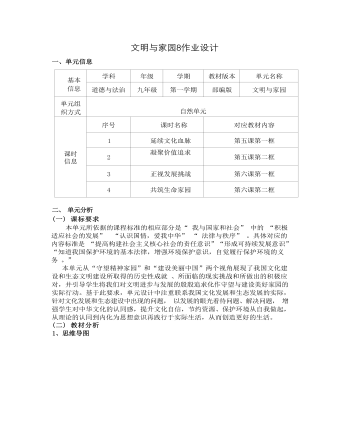
九年级上册道德与法治文明与家园8作业设计
1、在中华民族发展的历程中,形成了代代传承的中华传统美德。下列诗句中,体现中华传统美德是 ( )。①苟利国家,不求富贵 ②捧着一颗心来,不带半根草去③天下兴亡, 匹夫有责 ④老吾老以及人之老, 幼吾幼以及人之幼A.①②③ B.②③④ C.①②④ D.①②③④2、戏曲是中国传统文化中的灿烂瑰宝。近年来, 湖北京剧二团坚持开展“戏曲进校园”活动, 举办戏曲知识讲座, 并进行经典戏曲展演, 弘扬和传承了中华 传统文化。下列属于弘扬和传承中华传统文化的有 ( )。①全校举行剪纸活动比赛 ②端午节吃粽子、插艾草、赛龙舟③清明节学校组织学生到烈士陵园祭拜先烈 ④学校开展法治进校园活动A.①②③ B.①③④ C.②③④ D.①②④3、近年来,“沙尘暴”“雾霾”等恶劣天气频频出现,给人们的生产生活产生很大影响。对此下列说法正确的是 ( )。①我们应正确处理经济发展与资源、环境之间的关系

人教版新课标小学数学一年级下册读数、写数教案
教学目标:1、使学生知道个位和十位的意义,能正确熟练地读写100以内的数。2、通过读数和写数,进一步培养学生的数感。3、指导读数和写数都是从高位开始,并能知道数位的顺序,知道各个数位上数表示的含义。4、激发学生主动探究的欲望,增强学生的学习兴趣,体验成功的喜悦。教学重点:掌握读数与写数的方法,能正确写出100以内各数。教学难点:数位意义和理解。教学关键:通过读数、写数,培养学生的数感。一、激趣导入同学们,今天老师要带大家到数学乐园去玩 。你看,小猫咪已经在门口欢迎我们了。咦,小兔子从门口蹦了出来,它说:不行,不行,你们想进数学乐园去可得回答我的几个问题。”同学们,你们敢接受小兔子的挑战吗?那可得看仔细了。1、从31数到36,从56数到66。2、我说前一个数,你们说后一个数。
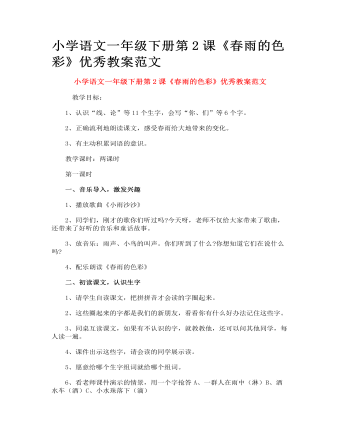
小学语文一年级下册第2课《春雨的色彩》优秀教案范文
精读课文,理解积累 1、同学们的字记的很好,课文也一定能读出感情来。现在就请同学们带着自己的理解和感受,有感情地读一遍课文,并自己喜欢的一段精读。 2、讨论交流,指导朗读 调整方案: 方案一:通过读文你知道了什么?(这一问题较开放,如果学生已从整体上感知课文内容,即可进入下一环节。如果学生回答只停留在零散的词句上,就按方案二教学。) 方案二:小燕子、麻雀和黄莺它们分别认为春雨是什么色的?他们为什么这么认为?(板贴写有字的小写图片和对应的颜色) 3、小组内讨论:a.如果分角色朗读的话,该怎样读争论的语法,朗读好“不对”“不对,不对”“你们瞧”b.怎样表现春雨小鸟和大自然。 4、根据自己的理解感受小组内分角色读、表演读。 5、请一组同学配乐表演读,学生评价 6、同学们春雨到底是什么颜色的呢?把你的想法说一说,画一画(自选粉笔板画春雨) 7、指导积累。同学们读得真有感情,现在请把你喜欢的词句画下来。
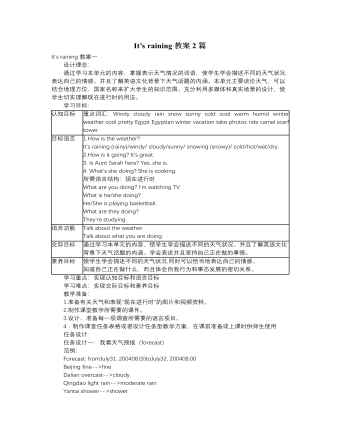
人教版新目标初中英语七年级下册It’s raining教案2篇
1 Each group choose one place to describe and what you are doing in it Choose one place, and describe what they are doing 2 Move around the room and give suggestions Talk about it and write it down 3 Ask one to show their works and act it Choose one of each group to make a report 4 Evaluate the best group and the best reporter Choose the best one Homework Ask your friends their ideal place and write about it教学反思:新课程标准中强调学生在课堂中的主体地位,在综合课中他们的主体地位就更加突出。在各个活动中给不同程度的学生不同层次的任务,让各层面的学生都有表现发挥的机会,从而产生对英语的兴趣。使用照片图片多媒体来辅助教学,效果更好。同时让了解其他国家风景,风俗的同学介绍ideal place,增加学生的背景知知识,实现跨学科交流的目的。教案点评:采用任务型教学模式,在各个活动中给不同程度的学生不同层次的任务,让各层面的学生都有表现发挥的机会,从而产生对英语的兴趣。使用照片图片多媒体来辅助教学,效果更好。让了解其他国家风景,风俗的同学介绍ideal place,增加学生的背景知识,实现跨学科交流的目的。
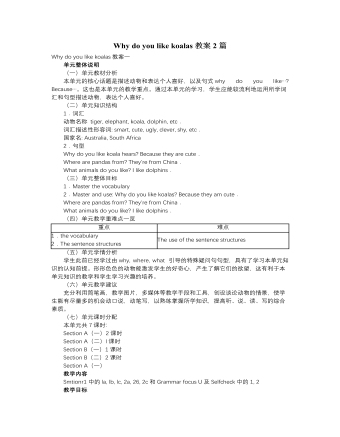
人教版新目标初中英语七年级下册Why do you like koalas教案2篇
单元整体说明(一)单元教材分析本单元的核心话题是描述动物和表达个人喜好,以及句式why do you like…? Because…。这也是本单元的教学重点。通过本单元的学习,学生应能较流利地运用所学词汇和句型描述动物,表达个人喜好。(二)单元知识结构1.词汇动物名称 tiger, elephant, koala, dolphin, etc.词汇描述性形容词: smart, cute, ugly, clever, shy, etc.国家名: Australia, South Africa2.句型Why do you like koala hears? Because they are cute.Where are pandas from? They're from China.What animals do you like? I like dolphins.(三)单元整体目标1.Master the vocabulary2.Master and use: Why do you like koalas? Because they am cute.Where are pandas from? They're from China.What animals do you like? I like dolphins.(四)单元教学重难点一览(五)单元学情分析学生此前已经学过由why, where, what 引导的特殊疑问句句型,具有了学习本单元知识的认知前提。形形色色的动物能激发学生的好奇心,产生了解它们的欲望,这有利于本单元知识的教学和学生学习兴趣的培养。
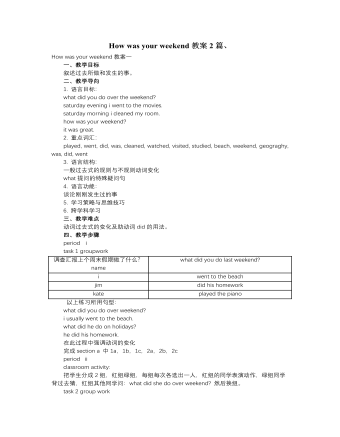
人教版新目标初中英语七年级下册How was your weekend教案2篇
Teaching Goal:1. General aims:Talk about recent past events2. Particular aims:A. Language Focus.Talk about recent past events and think of the past events.B. Language goalsHow was….?It was …What did …do over the weekend?C. Language structures:(1). How was your weekend? I was great. Pay attention to no form.(2). What did you do over the weekend? I played soccer. We went to the beach.D. Useful words and phrases:Words: was, did, went, beach, over, project, test, wasn’t, false, number, geography, spend, week, most, mixture, their, had, little, cook, read, saw, change, everyone, sit, sat, no, anythingPhrases: did one’s homework, played soccer, cleaned my room, went to the beach, played tennis, went to the movies, on Saturday morning, over the weekend, cook … for, what about, do some reading, have a party, talk show, go shoppingE. Grammar language:Present simple past tenseRegular and irregular verbsF. Learning strategies:Tour and holidaysG. Interdiscipinary:H. Emotion and manner:Teaching time: 5 periodsTeaching procedures:Period One教学步骤、时间 教师活动 学生活动 媒体应用Step 1Free talk 3’ Ask some questions like:Who’s on duty today?What’s the weather like? Answer and talk about something.让同学们回答下列问题1. Do you like weekend? (Let some students answer)It takes them three minutes to talk about the question.2. Why do you like weekend? (let the students answer) Most of the students like the weekend此时教师用汉语问:“在周末期间问你干了什么?这句话用英语这么回答?Let the students guess.At last the teacher give them right answer3. What did you do over the weekend?(板书、学习)
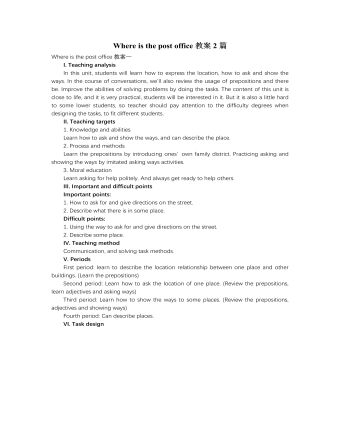
人教版新目标初中英语七年级下册Where is the post office教案2篇
Period 2 (3a----Section B 2c)Preview(Pre-task): Key points: What laAdd another information about their pen pals----their language on the cardnguage does she/he speak?She/He speaks....Does she/he have any brothers and sisters? Does she/he speak English?Preview(Pre-task): Add another information about their pen pals----their language on the cardKey points: What language does she/he speak?She/He speaks....Does she/he have any brothers and sisters? Does she/he speak English?Step 1 Revision1.Revisionand dictation of the new words 2.Revise the drills they learned yesterday.(by pairwork and grammar exercise)Step 2 Leading-inT has a conversation with one student. The conversation is following:---Do you have a pen pal?---Yes, I do.---What's your pen pal's name? ---His/Her name is....---Where is your pen pal from? ---He/She is from...---Where does he/she live? ---He/She lives in....---What language does he/she speak?He/She speaks...Write the new words on the Bb. They are following: EnglishChineseJapaneseFrenchStep 3 LearnLearn the new words with the whole class.Finish 3a with the students3b Pairwork T still does an example with one student Then the Ss practise in pairs. The example is following:--Curry Muray is my pen pal. He is from the United States.---What language does he speak?
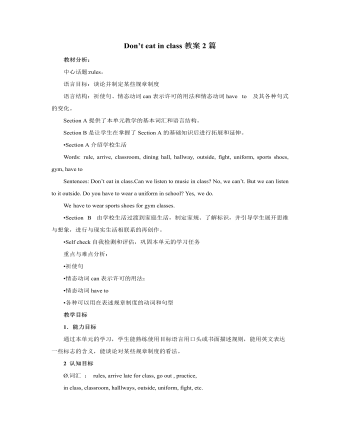
人教版新目标初中英语七年级下册Don’t eat in class教案2篇
Don’t fight. =You can’t fight. (板书,教读)教师把这些句子板书在黑板上,并请学生大声整齐地读祈使句和“can’t”句型,并让学生注意两种句型表达形式的不同和转换,“Don’t …=You can’t…”;并对学生说:These are our school rules. (板书,教读) You can’t break the school rules. Don’t break the school rules.(板书,教读)步骤3 :Practicea. T: Now, each of the students is breaking one of these rules.Please finish 1a.学生看图,完成1a的内容,检查答案并大声朗读校规。b. 听录音,完成1b,选出四位学生都违反了哪条校规;听之前,学生要读会英文名。c. 请两位学生朗读1c部分的句型;要求学生两人一组对话表演,SA扮演外校转来新生,SB告知本校校规。(学生可经过讨论,多说出他们想到的校规,不必只限于书上;教师应给予帮助)2) 第二课时(2a~4)步骤1 :warming up of revisionT: What are the rules at your school?学生使用“can”或祈使句表达各条校规;其中老师可引出“eat in the cafeteria outside”的表达。步骤2 :Practicea.T: Christina is an exchange student. She doesn’t know the rules. Let’s listen, what activities they’re talking about?学生听第一遍时,完成2a;第二遍时,完成2b;b. 请学生领读2c部分,看着2a完成的表格,理解2c活动的要求;分成小组针对2a进行问答;
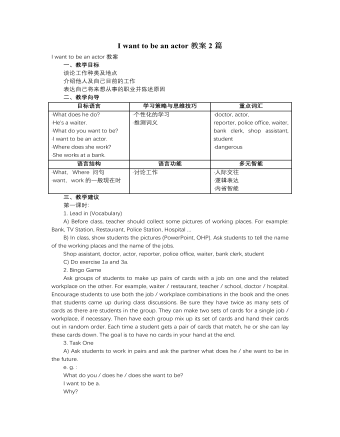
人教版新目标初中英语七年级下册I want to be an actor教案2篇
三、教学建议第一课时:1. Lead in (Vocabulary)A) Before class, teacher should collect some pictures of working places. For example: Bank, TV Station, Restaurant, Police Station, Hospital ...B) In class, show students the pictures (PowerPoint, OHP). Ask students to tell the name of the working places and the name of the jobs.Shop assistant, doctor, actor, reporter, police office, waiter, bank clerk, studentC) Do exercise 1a and 3a.2. Bingo GameAsk groups of students to make up pairs of cards with a job on one and the related workplace on the other. For example, waiter / restaurant, teacher / school, doctor / hospital. Encourage students to use both the job / workplace combinations in the book and the ones that students came up during class discussions. Be sure they have twice as many sets of cards as there are students in the group. They can make two sets of cards for a single job / workplace, if necessary. Then have each group mix up its set of cards and hand their cards out in random order. Each time a student gets a pair of cards that match, he or she can lay these cards down. The goal is to have no cards in your hand at the end.3. Task OneA) Ask students to work in pairs and ask the partner what does he / she want to be in the future.e. g. :What do you / does he / does she want to be?I want to be a.Why?Because it's (adj).B) Vocabulary: Section B, 1a4. Homework 1.2.
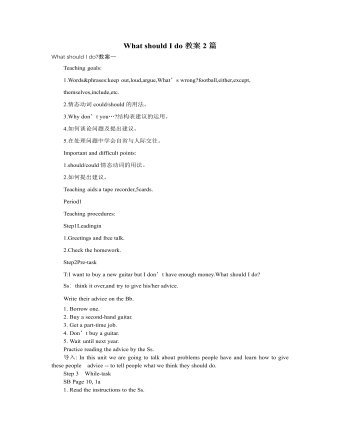
人教版新目标初中英语八年级下册What should I do教案2篇
说明:在帮Li Lei提建议的同时,教育学生如何学好英语。第三课时教学目标1. 语言目标:a) 词汇: Original, in style, haircut, the same as.b) 语言结构:My friend wears the same clothes and has the same haircut as I do.2. 能力目标:大多数学生能够谈论自己喜欢哪种服装,提高查找信息的能力。3. 情感目标:学会如何与朋友相处,要有自己对时尚的看法。教学重点掌握一些重要词汇。教学难点学会谈论问题,并能提出书面建议。◆教学突破首先针对Erin的问题,提出个人的建议,模仿2c部分的对话展开双人交际Pair-work;听老师诵读3a部分的信件,并找出LEFT OUT的问题所在;学生完成3b部分的内容,给Left Out提出书面的建议;学以口头形式提出自己目前存在的某个问题,讲给大家听,让同学们给自己提出一个建议,并作笔录;学生两、三个人分成一组,随意性地进行口语交际,谈论P14的第4部分的某个问题,相互交换意见。
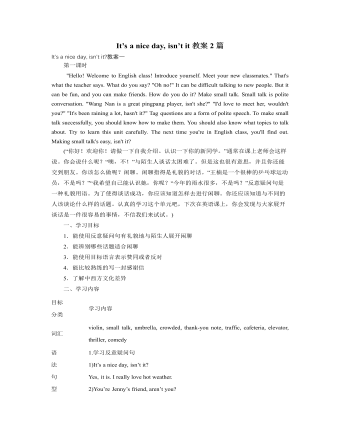
人教版新目标初中英语八年级下册It’s a nice day, isn’t it教案2篇
"Hello! Welcome to English class! Introduce yourself. Meet your new classmates." That's what the teacher says. What do you say? "Oh no!" It can be difficult talking to new people. But it can be fun, and you can make friends. How do you do it? Make small talk. Small talk is polite conversation. "Wang Nan is a great pingpang player, isn't she?" "I'd love to meet her, wouldn't you?" "It's been raining a lot, hasn't it?" Tag questions are a form of polite speech. To make small talk successfully, you should know how to make them. You should also know what topics to talk about. Try to learn this unit carefully. The next time you're in English class, you'll find out. Making small talk's easy, isn't it? (“你好!欢迎你!请做一下自我介绍。认识一下你的新同学。”通常在课上老师会这样说。你会说什么呢?“噢,不!”与陌生人谈话太困难了。但是这也很有意思,并且你还能交到朋友。你该怎么做呢?闲聊。闲聊指得是礼貌的对话。“王楠是一个很棒的乒乓球运动员,不是吗?”“我希望自己能认识她,你呢?“今年的雨水很多,不是吗?”反意疑问句是一种礼貌用语。为了使得谈话成功,你应该知道怎样去进行闲聊。你还应该知道与不同的人该谈论什么样的话题。认真的学习这个单元吧,下次在英语课上,你会发现与大家展开谈话是一件很容易的事情,不信我们来试试。)
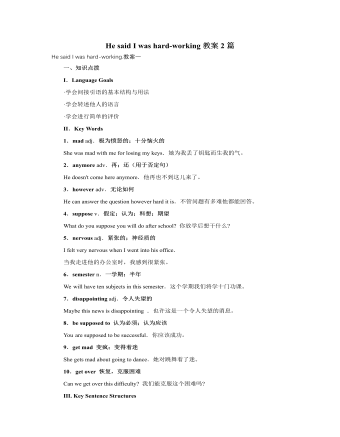
人教版新目标初中英语八年级下册He said I was hard-working教案2篇
This activity introduces some new vocabulary and provide oral practice using the target language.Task 1 . Ask four students to stand in front of the class, and the teacher asks them the following questions as a reporter.1.What are you going to do when you grow up?2.What are you going to do next week?3.What are going to do after school?The students will give different answers, then ask a good student to report what they said.I am going to e a doctor.What did she say?----------She said she was going to be a doctor.I am going to have a party on Friday night.What did he say?-------He said he was going to have a party on Friday night.I am going to do my homework.What did she say ?------ She said she was going to do her homework.I am going home after school.What did she say?-----She said she was going home after school.Say In this unit we are going to learn to use words like to report what someone said.Task 2. Read the instructions. Then ask a student to read the four questions. And write the words on the Bb. Explain what soap opera is.Task 3. Ask the students to Look at the pictures, point out the TV screens in the picture. Ask one girl to read what Marcia said.What did Marcia say? She said She said she was having a surprise party for Lana on Friday night. Repeat the other pictures in the same way.Activity3. Listen and number the pictures in activity 1a.
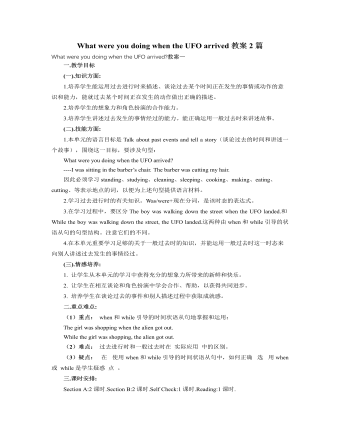
人教版新目标初中英语八年级下册What were you doing when the UFO arrived教案2篇
(一).知识方面: 1.培养学生能运用过去进行时来描述、谈论过去某个时间正在发生的事情或动作的意识和能力,能就过去某个时间正在发生的动作做出正确的描述。 2.培养学生的想象力和角色扮演的合作能力。 3.培养学生讲述过去发生的事情经过的能力。能正确运用一般过去时来讲述故事。 (二).技能方面: 1.本单元的语言目标是Talk about past events and tell a story(谈论过去的时间和讲述一个故事),围绕这一目标,要涉及句型: What were you doing when the UFO arrived? ----I was sitting in the barber’s chair. The barber was cutting my hair. 因此必须学习standing、studying、cleaning、sleeping、cooking、making、eating、cutting、等表示地点的词,以便为上述句型提供语言材料。2.学习过去进行时的有关知识。Was/were+现在分词,是该时态的表达式。 3.在学习过程中,要区分The boy was walking down the street when the UFO landed.和While the boy was walking down the street, the UFO landed.这两种由when和while引导的状语从句的句型结构。注意它们的不同。
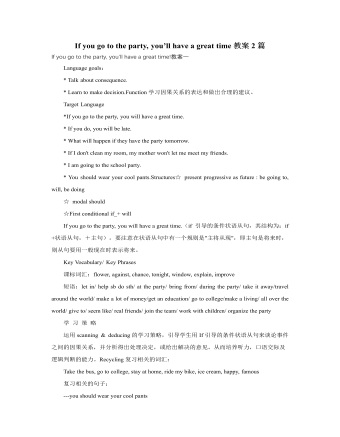
人教版新目标初中英语八年级下册If you go to the party, you’ll have a great time教案2篇
区分宾语从句、定于从句和状语从句宾语从句和状语从句,都叫做主从复合句。宾语从句主要是中考必考的,是初中阶段必掌握的从句,宾语从句主要是掌握三要素,所谓宾语从句,就是宾语在主从复合句当中充当宾语的一个句子,叫做宾语从句。主句的谓语动词是及物动词,后面如果是词或者是短语的话,是简单句,如果是句子的话,肯定是宾语从句。I know that he good at English.就是宾语从句,三要素,一要素是要注意连词,连词一共学了三类连词,一类连词是that口语当中可以省略,就像刚才说的那一句,I hear he is good at English.还有疑问代词、疑问副词,how where when,疑问代词、疑问副词。还有一类连词weather是否的意思,不是状语从句当中的如果,这一定要和如果区分开,这是是否。I don't know if he interested at English。宾语从句要注意if是连词。第二要素是语序,要用陈述举语序。比如说你家有几口人,我们都说How many people are there in you family?但是这是简单句,一旦说成宾语从句,你可以告诉我你家有几口人吗?Could you tell me how many people there are in you family ?





















